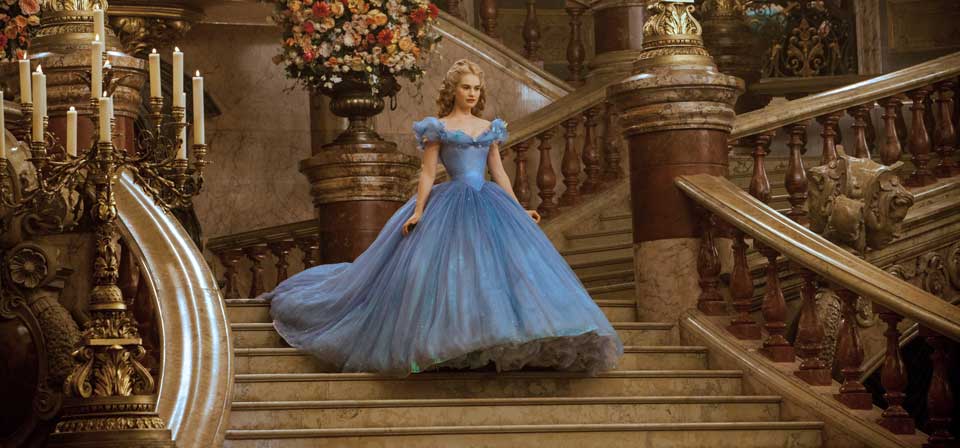Cinderella (1950)
Coming in the wake of a string of early classics — Snow White and the Seven Dwarfs, Pinocchio, Fantasia, Bambi — Disney’s Cinderella represents, alas, the early stages of Disney-itis. Although it more or less follows the fairy-tale template laid down by Charles Perrault — which is more than could be said for such later efforts as The Little Mermaid — Cinderella doesn’t do much to elevate the material the way earlier features did.
Caveat Spectator
Nothing objectionable.The tunes are mostly less than classic: “A Dream is a Wish Your Heart Makes”; “So This is Love” The one standout, of course, is “Bibbidi-Bobbidi-Boo” (though I prefer the fairy godmother’s song from the Rodgers & Hammerstein versions, with its “Fol-de-rol and fiddle dee dee”).
The cute Disney animal sidekicks, always present, here for the first time overstep their bounds into the main plot. The cat Lucifer (voiced by June Foray and looking like an evil forerunner of the Cheshire Cat from Alice in Wonderland), Cinderella’s mouse friends Jaq and Gus (both voiced by James MacDonald, who knew from mouse voices, being the voice of Mickey himself), and the old dog Bruno (MacDonald again) are used to pad out the story with “Tom and Jerry”–style cat-and-mouse hijinks before ultimately being given key roles in an action-packed climactic scene in which Cinderella’s mice friends must get the key up the stairs and rescue her from her tower. (The mice do play one key role in the story that reflects Perrault’s text: Enchanted by Cinderella’s fairy godmother, they become the horses drawing her pumpkin-carriage.)
Cinderella herself (Ilene Woods), alas, is blandly generic, and her interactions with Prince Charming (William Phipps) lack the spark of, say, Sleeping Beauty’s meet cute in the woods. Some reviews, looking for something to praise in the animation, have pointed to a few more interesting visual moments like the soap bubble reflections, but Disney had already done this sort of thing, and done it better, in the likes of Dumbo and Fantasia.
Which is not to say that Cinderella is visually uninteresting. The character design and animation may be unremarkable, but what is most worthy of note is the background art. Immense, cavernous spaces fill the film, from the opulent Baroque ballroom of the royal palace, with its tall, narrow doors reaching to an impossibly remote ceiling, to the vertiginous stone tower with its rough wooden staircase leading to Cinderella’s bedroom/cell. These fairy-tale spaces leave a lasting impression on the imagination, evoking as they do the timeless world of Perrault, the Brothers Grimm, and Hans Christian Anderson.
Though not Disney’s finest hour, Cinderella is an honorable rendition of the fairy tale and a worthwhile family classic. It’s also worth noting that this version provides one notable variation on the classic fairy tale that couldn’t have existed prior to Perrault’s retelling, which introduced the detail that Cinderella’s magical slippers were of glass. (Some scholars have hypothesized that this detail was originally based on a misreading, and that the “glass” [verre] slippers were originally fur [vair], but it could also be that Perrault simply liked the idea of glass slippers. Certainly glass, besides being a more exotic material, suggests a more exacting point of reference in a shoe that could be worn by only one foot in the kingdom.)
In any case, once it’s established that the slippers are of glass, this raises the obvious possibility of the slipper breaking. Of course there is only one logical response to this eventuality — and Cinderella provides it, offering a satisfying twist on the Cinderella story and a clever denouement to the film.
Related

Cinderella (2015)
Kenneth Branagh’s Cinderella is such a gallant anachronism, such a grandly unreconstructed throwback, that it offers, without ever raising its voice, a ringing cross-examination of our whole era of dark, gritty fairy-tale revisionism.
Rodgers & Hammerstein’s Cinderella (1965)
There may be no dethroning the Disney cartoon as the definitive musical retelling of the story of Cinderella in the popular imagination; but for my money Rodgers & Hammerstein’s made-for-TV musical is a better take on the timeless fairy tale set in stone by Charles Perrault, and a better introduction to the story for children.
Rodgers & Hammerstein’s Cinderella (1957)
Despite the formidable star power of no less than Julie Andrews, this original version of Rodgers & Hammerstein’s made-for-TV musical Cinderella has been astonishingly neglected, overshadowed by the 1965 version starring Lesley Ann Warren.
Recent
- Benoit Blanc goes to church: Mysteries and faith in Wake Up Dead Man
- Are there too many Jesus movies?
- Antidote to the digital revolution: Carlo Acutis: Roadmap to Reality
- “Not I, But God”: Interview with Carlo Acutis: Roadmap to Reality director Tim Moriarty
- Gunn’s Superman is silly and sincere, and that’s good. It could be smarter.
Home Video
Copyright © 2000– Steven D. Greydanus. All rights reserved.